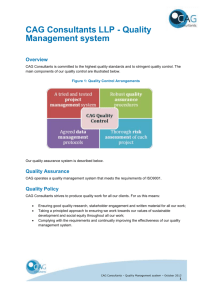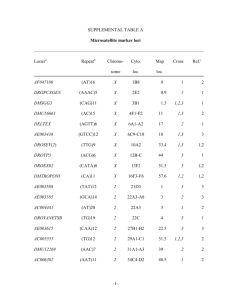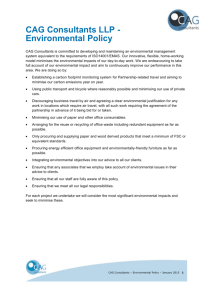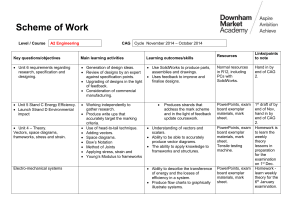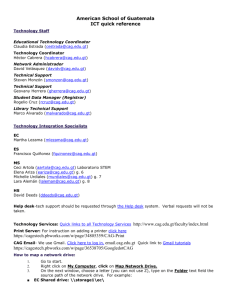Libby Community Advisory Group Meeting Summary February 8, 2007 Introductions
advertisement
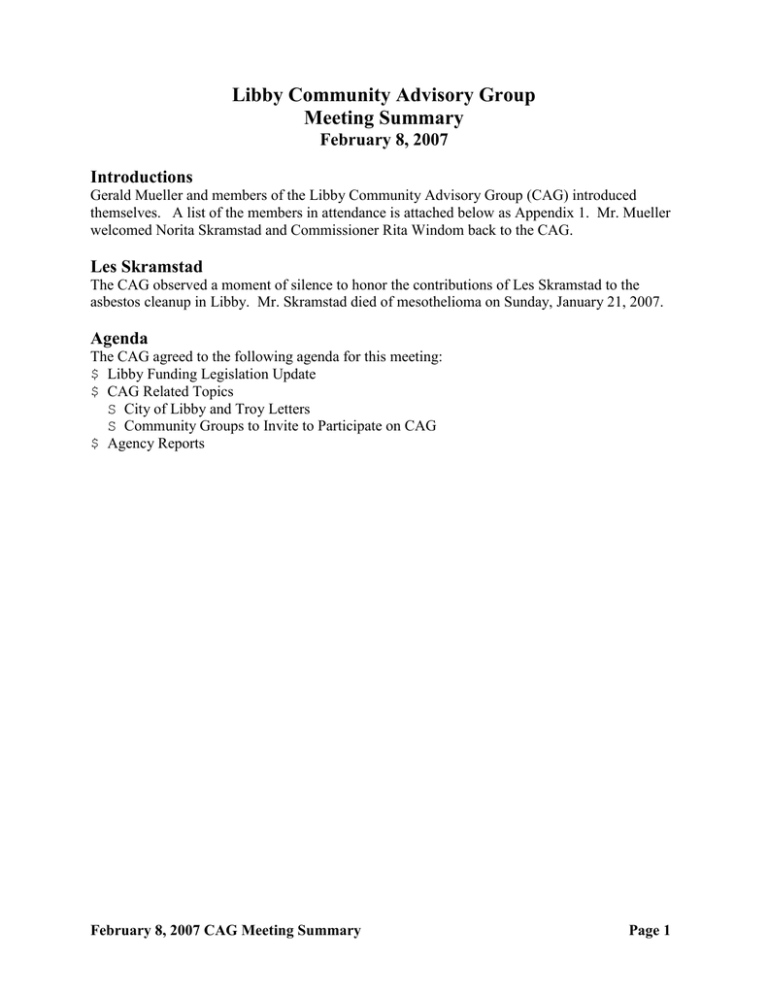
Libby Community Advisory Group Meeting Summary February 8, 2007 Introductions Gerald Mueller and members of the Libby Community Advisory Group (CAG) introduced themselves. A list of the members in attendance is attached below as Appendix 1. Mr. Mueller welcomed Norita Skramstad and Commissioner Rita Windom back to the CAG. Les Skramstad The CAG observed a moment of silence to honor the contributions of Les Skramstad to the asbestos cleanup in Libby. Mr. Skramstad died of mesothelioma on Sunday, January 21, 2007. Agenda The CAG agreed to the following agenda for this meeting: $ Libby Funding Legislation Update $ CAG Related Topics S City of Libby and Troy Letters S Community Groups to Invite to Participate on CAG $ Agency Reports February 8, 2007 CAG Meeting Summary Page 1 Review Draft - Not for Quotation S S S S EPA TAG CARD LAMP February 8, 2007 CAG Meeting Summary Page 2 Review Draft - Not for Quotation $ Public Comment $ Next Meeting Agenda Libby Funding Legislation Update Bill Patten reported on the status of HB 407, sponsored by Rep. Chas Vincent. Its purpose is to appropriate $1.5 million per year for 2008 and 2009 fiscal years to providing funding to help pay medical and personal service costs for people of Libby suffering from asbestos-related disease. The bill had a hearing on February 2, 2007 before the House Appropriation Committee. Rep. Ralph Heinert, Sen. Aubyn Curtis, LeRoy Thom, Karol Spas, Ms. Reinhart (Mick Mills’ granddaughter), Mr. Patten, and Gerald Mueller testified in support of the bill. Letters of support from Commissioner Windom and Dr. Brad Black were read. No one testified in opposition to the bill. A spokesperson for the Montana Department of Public Health and Human Services testified as an informational witness pointing out that the bill as drafted would not direct money only to Libby, and that DPHHS may require additional staffing to administer the funds. Other communities such as Great Falls that had asbestos exposure as a result of the Libby operations may also qualify for funding. The Chairman of the Appropriations Committee, Rep. John Sinrud, stated that the bill would be amended to tighten the eligibility criteria to ensure that the money would go to those who need it in Libby. Mr. Patten stated that Committee members asked a number of good questions that indicated that they did not understand the facts surrounding the situation at Libby. They were uncertain about the meaning the “silver bullet,” whether the EPA Superfund cleanup also provided health care, and whether after the litigation against WR Grace is completed that the state might be repaid any money appropriated by HB 407. In answering the questions, Mr. Patten explained that sufficient funding is not available to meet the community’s asbestos-related health care costs, that EPA funding is for the cleanup and not health care, and that the litigation against WR Grace by individuals would not provide a source of funds to repay the state. Mr. Mueller stated that while he testified in support of the Libby community, he did so on behalf February 8, 2007 CAG Meeting Summary Page 3 Review Draft - Not for Quotation of himself only, not as a representative of CAG or the Libby community. February 8, 2007 CAG Meeting Summary Page 4 Review Draft - Not for Quotation CAG Related Topics February 8, 2007 CAG Meeting Summary Page 5 Review Draft - Not for Quotation Libby and Troy Letters - Mr. Patten stated that as directed by the CAG at its last meeting, letters were sent to the Cities of Libby and Troy asking that they each appoint a representative to serve as a CAG member. To date, no replies have been received. DC Orr reported that City Council Member Walt McElmurry will be attending CAG meetings, but was unable to do so this time. Community Groups to Invite to Participate on CAG - The CAG identified the following groups that should be invited to have a representative as a CAG member: February 8, 2007 CAG Meeting Summary Page 6 Review Draft - Not for Quotation Chamber of Commerce Realtor Association United States Forest Service Banking Community Libby Homeowners Association Libby Ministerial Association EM KAYAN Village, Northwood, and Woodway Park Homeowners Associations Libby Rotary Club Troy Businessmen's Group Lincoln County Fire Coop Contractors working for EPA on the cleanup February 8, 2007 CAG Meeting Summary Page 7 Review Draft - Not for Quotation CAG Action - Rather than merely writing to these groups to seek their participation as a member, the CAG agreed that someone should contact each group and solicit their interests and needs that membership might address, and why they are no longer participating if they once did. A committee including Bill Patten, LeRoy Thom, Gordon Sullivan, and Lerah Parker agreed to organize this effort including developing a survey regarding CAG participation that can be posted on St. John Lutheran Hospital’s web site so that anyone can take it. The CAG also agreed that it would not continue revising its mission and operating procedures until after these groups are contacted so that any new CAG members can participate in these decisions. LeRoy Thom stated that he and Bill Patten were interviewed today by the local radio station to discuss the CAG’s ongoing effort to redesign and revitalize itself. Audience Member Question - Is there a cap on the number of CAG members? Answer by LeRoy Thom - Originally, the CAG had 27 members. Answer by Bill Patten - No cap exists. The “problem” of having too many members would be wonderful. CAG Member Question - Have we agreed to a fixed percentage of members who represent community organizations and just themselves? Answer by Gerald Mueller - At its last meeting, the CAG discussed having both types of members, but did not agree to a specific percentage of each. EPA Report Paul Peronard and Ted Linnert reported for EPA on the following topics. Libby Relocation Rumors - A recent newspaper story reported and rumors indicate that EPA is considering relocating the town in response to the asbestos contamination. The story and rumors are false. EPA is not considering relocating the town. Ambient Air Sampling - News stories today report that EPA ambient air sampling in Helena detected Libby amphibole asbestos. As we stated at the last CAG meeting, one sample in Helena February 8, 2007 CAG Meeting Summary Page 8 Review Draft - Not for Quotation contained six fibers. We do not know the source of these fibers. February 8, 2007 CAG Meeting Summary Page 9 Environmental Resource Specialist Position - Mike Cirian is continuing to pilot this position. Since the beginning of December, he responded to four incidents. Three were routine. The fourth was a house fire on Michigan Avenue. The house was vacant at the time of the fire, and was scheduled for demolition in the spring because it was structurally unsound. Heat from the fire caused the front windows of the house to blow out, and, as a result, vermiculite insulation spread across the street from the house. The ground was snow covered. Firefighter clothing and personal vehicles were contaminated. Because of we do not know how to sample snow for asbestos, and the area experienced heavy foot traffic as the fire was fought, we will have to come back in the spring to sample the area for contamination. Valuable lessons were learned in this incident. First, we need to beef up monitoring during and after a fire. Second, we need to work with the fire department on decontamination and respiratory protection. A second set of turn-out gear, the clothing and equipment the fire fighters wear when responding to a fire, is need for the firefighters. Third, we need to ensure that the police and fire departments have information about property contamination status, so they know which have contaminated vermiculite insulation. These are issues that will be addressed by the Operation and Maintenance Work Group. Audience Member Question - When a fire occurs, do you set out ambient air monitors? Answer - Stationary monitors will not tell us much. We will likely increase the use of personal air monitors and perhaps monitor at the closest residence to the fire. We will develop a plan for air monitoring in response to fires. Audience Member Question - Where was the closet ambient air monitor to the Michigan Avenue house fire? Answer - The nearest was six blocks away. CAG Member Question - Don’t the fire fighters have two sets of turn-out gear? Answer - There are about thirty sets of gear and over twenty volunteer fire fighters, not enough for two sets per person. CAG Member Comment - I know that fire fighters literally keep their turn-out gear next to their beds so they can respond to a fire without delay. Are they taking contaminated gear home? Answer - The fire department presently has one wash machine to clean clothing worn at fires. We have called Senator Baucus and Tester’s offices to make them aware of the need associated with fire fighting. Tom Wood, Chief of the Libby Volunteer Fire Department, has met with Congressional staff seeking assistance. Audience Member Question - Have you considered providing fire fighters disposable clothing? Answer - We have supplied disposable Tyvek suits and respirators, but we don’t have enough to solve the problem. CAG Member Comment - Tom Wood met with the Operations and Maintenance Work Group. He indicated that in the past the fire department has not taken the asbestos contamination as seriously as it should, but this has changed. February 8, 2007 CAG Meeting Summary Page 10 CAG Member Question - What about the Lincoln County Fire Coop? Answer - We are sharing lessons learned and equipment with the County Fire Coop as well. CAG Member Comment - I have a son who recently joined the fire department. What fire fighters need is a completed risk assessment. Answer - You are right. We need bench marks to guide management decisions regarding the efficacy of the cleanup and what contamination, if any, can be left safely behind. We have two issues to address before we can develop the risk assessment. First, we need information on the toxicology of the Libby amphibole. Second, we need to complete the sampling investigation which includes both ambient air sampling and activity based sampling to characterize exposures. EPA recently convened a meeting at Research Triangle Park in North Carolina to discuss issues related to the Libby risk assessment. The meeting was attended by EPA scientists from headquarters, Region 8, and other regions. Scientists and officials from the National Institute of Occupational Health and the Agency for Toxic Substances and Disease Registry also attended. Gayla Benefield and Dr. Gerry Henningsen from the Libby Technical Advisory Group (TAG) also attended to provide insight into the situation in Libby. A plan to address the toxicological data gaps is being developed. The draft plan includes animal studies and epidemiology analyses of past exposures at Libby and a former Owens Scott plan in Ohio that handled Libby vermiculite. The draft plan includes eleven projects and will take over two years to complete. Data from these projects that we can use to affect the cleanups here will start being available in a matter of months. We meet at EPA headquarters next week to decide on funding for the toxicology work. We will circulate the toxicology work plan to the CAG through its facilitator. Town Meeting - EPA will conduct a town meeting on March 7, 2007 at the Memorial Center from 7 - 9:00 p.m. to discuss the toxicological plan that will fill in the data gaps for the risk assessment. State Report Catherine LeCours reported on behalf of the state. On April 30, the pre-cleanup investigation in Troy will begin. The state has obtained office space near the Troy City Hall that it will occupy during the investigation and cleanup. Brain Goodman of the Montana Department of Transportation will report on the results of the Highway 37 asbestos sampling at the next CAG meeting in March. TAG Report February 8, 2007 CAG Meeting Summary Page 11 Review Draft - Not for Quotation Mike Noble and Dr. Gerry Henningsen reported on behalf of the TAG. As Paul Peronard stated, Gayla Benefield and Dr. Henningsen attended the EPA meeting at Research Triangle Park. Dr. Henningsen said that he has never seen EPA move as quickly as it is to address the toxicology issue. February 8, 2007 CAG Meeting Summary Page 12 CAG Member Question - Did EPA cover the expenses of Ms. Benefield’s and Dr. Henningsen’s presence at this meeting? Answer - Yes. CAG Member Question - Why didn’t Mr. Noble, the new TAG chairman attend this meeting? Answer - Gayla Benefield was invited when she was the chair. CARD Report Mike Giesey reported on behalf of CARD. He passed out a handout describing the series of three public meetings that CARD will be conducting, one each in February, March, and April. See Appendix 2. CARD would welcome an opportunity to make a half-hour presentation to any community civic group regarding its mission and plans. Please contact CARD if your group would like a presentation. CARD would also like time on next months meeting agenda to update the CAG about its plans and activities. Tanis Hernandez stated that representatives of the Karmanos Cancer Institute would like to make a presentation to the CAG at the April 12, 2007 CAG meeting. LAMP Report LeRoy Thom reported on behalf of the Libby Asbestos Medical Plan (LAMP). At a past meeting, Mr. Thom had been asked to provide a summary of LAMP’s payment activities. During 2006, the program provided $535,343.71 to pay for in- and out-of-state screening for 1013 individuals. Payments from LAMP totaling $272,774.79 were made to 926 people for medical care to supplement the coverage of the WR Grace medical plan. CAG Member Question - If we receive the $3 million from HB 407, and all of went to LAMP, how long do you estimate the money would last? Answer - Based on past rates of usage, I estimate two years. However, two factors may affect this estimate. First, LAMP has funding caps for individuals. Individuals may receive up to $25,000 in lifetime medical bill assistance and $12,000 maximum lifetime benefits for personal care. As people reach these limits, the existing LAMP funds may last longer than predicted by current expenditure rates. These limits apply to the $2.75 million received from the WR Grace EPA litigation settlement. If the HB 407 funding comes through, the community could discuss what limits should be placed on payments to individuals. Second, each year more people become ill, and coverage by the WR Grace medical steadily declines. The sickest people get the least amount of benefits from the WR Grace Plan. The increased illness and decreased WR Grace Plan support would tend to use up funds faster. If the HB 407 funding is approved, the community would have to decide what criteria and caps to apply to it. Audience Member Question - What happens to people when they reach their funding caps? Answer by Bill Patten - St. John’s Lutheran Hospital is concerned about this question. Last year, we did not receive payments for 32-33% of our gross billing. We cannot continue this level of write-offs. Audience Member Question - Do you know what amount of the write-off was involved asbestosrelated disease bills? Answer by Bill Patten - No. At present our billing system does not provide codes to provide such a break down. CAG Member Question - Can the bills be turned over to MEDICAID, when the money runs out? Answer by Tanis Hernandez - The MEDICAID program pays medical bills of low-income people. To qualify a person must have an income less than $560 a month and must either have dependent children, be deemed disabled by Social Security, or be over age 65). The majority of the patients that we see at CARD have long work histories and do not have low enough incomes to qualify for MEDICAID. CAG Member Comment - Neither the present LAMP funds, nor the $3 million from HB 407 address the long-term medical funding needs of this community due to asbestos-related disease. We need to keep working on this issue. CAG Member Comment - A subcommittee of the CAG has been discussing with WR Grace the possibility that it would establish and $400 - 500 million trust fund to pay for asbestos-related medical costs. WR Grace has responded that its hands are tied by the bankruptcy court. Public Comment CAG Member Question - Gene Reckin and Jeff Gruber, two Libby teachers, have recently returned from Minamata, Japan. They would like to make a presentation to the CAG at its next meeting about how Japan has responded to the mercury poisoning that occurred at Minamata. Next Meeting Agenda Topics The CAG agreed to the following topics for its next meeting: $ Report on the CAG membership survey; $ Report by the Montana Department of Transportation on its HW 37 survey results; $ CARD presentation; $ Minamata Project presentation; and $ Agency reports. Next Meeting The next meeting is scheduled for 7:00 to 9:00 p.m. on March 8, 2007 in the Ponderosa Room of Libby City Hall. Appendix 1 CAG Member & Guest Attendance List February 8, 2007 Members Mike Giesey DC Orr KW Maki Dr. Brad Black Rita Windom Ken Hays Group/Organization Represented CARD City of Libby Libby Schools Lincoln County Health Officer Lincoln County Commission Senior Citizens February 8, 2007 CAG Meeting Summary Page 14 Ted Linnert Bill Patten Paul Peronard Catherine LeCours LeRoy Thom Eileen Carney Norita Skramstad Gayla Benefield Gary D. Swenson Visitor Gerry Henningsen EPA St. John’s Lutheran Hospital EPA Montana Department of Environmental Quality Former Grace Employee Board of Respiratory Therapists TAG - LCAVRO Libby Volunteer Fire Department TAG Technical Advisor February 8, 2007 CAG Meeting Summary Page 15 Appendix 2 February 8, 2007 CAG Meeting Summary Page 16
